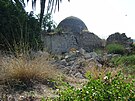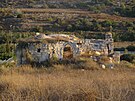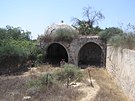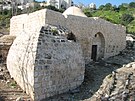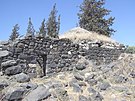Maqam (shrine)
AMaqām(Arabic:مقام) is aMuslimshrine constructed at a site linked to a religious figure orsaint,commonly found in theLevant(oral-Shām),which comprises the present-day countries ofLebanon,Syria,Palestine,andIsrael.It is usually a funeral construction, commonly cubic-shaped and topped with adome.

The cult for holy sites in Islamic Syria heightened during the 12th and 13th centuries, particularly underZangidandAyyubidrule. Historians attribute this surge to the political climate, notably theCrusadesand the Muslim reconquest of the region. Funded by rulers and the elite, these shrines functioned as points of piety, attracting individuals from different levels of society, generating employment opportunities, and contributing to economic growth.[1]During this period, as demand increased, more sanctuaries emerged, some repurposed from Jewish and Christian holy sites, others built upon newly discovered tombs and relics, and some dedicated to honoring the graves of recentulamaand revered holy men.[1]
| Part ofa serieson |
| Arabic culture |
|---|
 |
Maqams continued to be revered sites in modern times as well. In the 19th century,Claude Reignier Conderdescribed maqams as an essential part offolk religionin Palestine, with locals attaching "more importance to the favour and protection of the village Mukam than toAllahhimself, or toMohammedhis prophet ".[2][non-primary source needed][neutralityisdisputed]Researchers have observed that alongside celebrated Muslim figures, some maqams can also be associated withancient Semiticpagan,Judaic,Samaritan,andChristiantraditions.[3][4]
The maqams of Palestine were considered highly significant to the field ofbiblical archaeology,as their names were used in the 18th and 19th centuries to identify much ofbiblical geography.[5]
Etymology[edit]
From Arabic literally "a place" or "station."[6]It is used to denote a "sanctuary", such as a commemorative burial shrine or an actual tomb.[6]Its meaning can be restricted only to built structures that can be entered at such sites.[6]The literal meaning ofmaqamis "the place where one stands."[6]Such name for a holy tomb is mostly used inLebanon,SyriaandPalestine.
The formMukamappears in the essays of European travelers of the 19th century; as well as wordsWaly,Wely(Arabic:ويلي– tomb of a saint),Mazar (mausoleum),Mashhad.
InMaghrebsimilar tombs are known asMarabout,in Turkic-speaking Muslim countries asTürbe,Dürbe, Aziz and in Iranian-speaking countries –Dargah.
Purpose[edit]
Maqams were dedicated toBiblicalandQuranic,real or mythical, male and female figures from ancient times to the time of theArab conquestor even lateOttoman rule.[7]Ali Qleibo, a Palestiniananthropologist,states that this built evidence constitutes "an architectural testimony to Christian/Moslem Palestinian religious sensibility and its roots inancient Semitic religions."[4]In 1877, the British explorerClaude Reignier Conderwrote that:
It is in worship at these shrines that the religion of the peasantry consists. Moslem by profession, they often spend their lives without entering a mosque, and attach more importance to the favour and protection of the village Мukam than to Allah himself, or to Mohammed his prophet.[8]
Although, a study on Sheikh Shihab-Al-Din's Shrine that attracted rural Muslims from the village of Saffa showed that visitations usually consisted of ritual prayers, burials, reading of the Quran, commemoration of the Sheikh or the making of vows.[9]Every village in Palestine has awali,a patron saint, whom people, predominantly rural peasants, would call upon for help at his or her associated sanctuary.[10]Whilewalican refer to both the saint and sanctuary, a sanctuary for a common saint is more precisely known as a maqam.[11]

Construction[edit]
The most popular type of maqams is a single chamber square building topped with a dome, in the middle of which there is a stone cenotaph,[12]though the bodies of the revered figures themselves were buried below the ground level. In the south wall of the maqam, there is usually a smallmihrabfacingMecca,decorated with inscriptions and floral ornament. The entrance to the chamber is mostly at the north wall. In the other arched walls there are usually small windows. Candelabras and lamps are hanging in an active maqam, a cenotaph is covered by a quilt (usually a green one), praying rugs are spread on the floor in front of the mihrab.
There are also bigger maqams, consisting of two, three or four chambers:[13]prayer chamber, entrance hall, zawiya or a room for pilgrims to have a rest. Big maqams have two or three similar domes. In times of old, the dome was decorated by a metal spire with a crescent, but nowadays such decoration is rare.
The maqams are not always supposed to stand over the tombs of the saints to whom they are dedicated. Acenotaphis indeed almost always to be found there, but often they are regarded merely as "stations."

The dome is often situated by an ancientcaroboroak treeor a spring or rock cut water cistern.[4][14]A sacred tree was planted near maqams, mostly – a palm tree, oak orsycomore.There was also a well or spring. The positioning of maqams on or near these natural features is seen as indicative of ancient worship practices adapted by the local population and associated with religious figures.[15]
As a rule, maqams were built on the top of the hills or at the crossroads, and besides their main function – shrine and prayer place, they also served as a guard point and a guiding landmark for travelers and caravans. Over the years, new burial places appeared near maqams; it was considered as honour to be buried next to a saint. Big cemeteries formed around many Muslim sanctuaries.
History[edit]
Early origins[edit]
According toClaude Reignier Conder,many maqams are originated in Jewish and Christian traditions from before the advent of Islam in the region.[16]He identified seven types of maqams:[16]
- Biblical characters: "These are, no doubt, generally the oldest, and can often be traced back to Jewish tradition"
- Christian sites venerated by the Moslem peasantry: "not always distinguishable from the first class, but often traceable to the teaching of the monasteries or to monkish sites"
- Other native heroes or deities: "perhaps sometimes the most ancient sites of all"
- Later and known historic characters
- Saints named from the place where they occur, or having appellations connected with traditions concerning them
- Sacred sites not connected with personal names: "Some of these are of the greatest value"
- Ordinary Moslem names which may be of any date
Middle ages[edit]
In the seventh century, the ArabRashidunsconquered the Levant;they were later succeeded by other Arabic-speaking Muslim dynasties, including theUmayyads,Abbasidsand theFatimids.[17]Early Islam disapproved worshipping of holy men and their burial places, considering it a sort ofidolatry.However, theShiitesbuilt sumptuous tombs for their deceased leaders –imamsandsheikhs,and turned those tombs into religious objects. Very soonSunnisfollowed their example. Arab travellers and geographers‘Ali al-Harawi,Yaqut al-Hamawiand others described in their essays many Christian and Muslim shrines in Syria, Palestine and Egypt.
During the times ofMamluk dynasty,monumental tombs were built for Muslim holy men, scientists and theologists, some of these tombs have come down to present times. The major part of them is located in Egypt, and some parts are also in Syria and Palestine. These are namely the famousRachel's TombinBethlehem(though the burial place of matriarchRachelwas worshipped even before), the splendid mausoleum ofAbu HurairahinYavne[18]and the maqam of sheikh Abu ‘Atabi inAl-Manshiyya, Acre.
Ottoman period[edit]
In theOttoman Empiretimes, maqams were constructed everywhere, and old sanctuaries were taken under restoration. New buildings were not as monumental and pompous as before, and looked quite unpretentious. In Turkish period, maqams had simple construction and almost no architectural décor.

Mosques were uncommon in Palestinian villages until the late 19th century, but practically every village had at least one maqam which served as sites of worship in the Palestinian folk Islam popular in the countryside over the centuries.[10][14]Christians and Jews also held some of the maqams to be holy, such as that ofNabi Samwil.[11]In the period of Ottoman rule over Palestine, most of these sites were visited collectively by members of all three faiths who often travelled together with provisions for a multi-day journey; by theMandate Palestineperiod, politicization led to segregation.[7]Some maqams, likeNabi RubinandNabi Musaamong others, were also the focus of seasonal festivals (mawsims) that thousands would attend annually.
There is, however, in nearly every village, a small whitewashed building with a low dome – the "mukam," or "place," sacred to the eyes of the peasants. In almost every landscape such a landmark gleams from the top of some hill, just as, doubtless, something of the same kind did in the old Canaanite ages.[19]
Modern era[edit]

The period ofMandatory Palestinehas become the last time of maqams' prosperity. Dilapidated Muslims shrines were restored and also new ones built. The British built over and donated toBedouinsthe Maqam of sheikh Nuran, which was damaged during theSinai and Palestine Campaign.This maqam was in the battle epicenter during the1948 Arab–Israeli War.After having captured it, Israeli soldiers turned it into a watch and firing point. Since that time the maqam of sheikh Nuran is a memorial of theIsrael Defense Forces.
After the State of Israel was formed, numerous shrines were turned into Jewish religious shrines. It concerned themausoleum of sheikh Abu Hurairah,it which has become the tomb of RabbanGamaliel IIinYavne;[20]the Maqam with seven domes of Imam ‘Ali inYazurhas turned into asynagogueinAzor;themazarof Sitt Sakina (Sukeyna) has become Rachel's tomb, the spouse ofRabbi AkivainTiberias;the Maqam of sheikh al-Gharbawi – the tomb ofMattathias;the muqam of Nabi Sheman near theJunction Eyal,was identified with the tomb ofSimeon (son of Jacob).
In ancient times, all maqams with the domes were coloured in white.[21]Recently Palestinian and Israeli Arabs got used to colour the domes of their shrines in green (the colour of Islam). The battle for one or another shrine resulted in the war of colours, as it was called in press.[22]Religious Jewish paint the dome in blue or white and install Jewish symbols, and Muslims, when coming back, remove Jewish symbols and paint the dome in green.
Notable maqams[edit]
No more than 300 maqams have survived out of 800 existing in Palestine in 1948, the remainder having been demolished. Half of them are in Israel-proper, the remainder in theWest BankandGaza Strip;most of the West Bank has been under Israeli control since1967,and Gaza between 1967 and2005.According to another source, the number of Palestinian maqams left is 184, with only 70 remaining in Israel-proper.[23]
See also[edit]
- Dargah
- Datuk Keramat
- Imamzadeh
- Khanqah
- Maqbara
- Mazar
- Marabout
- Na Tuk Kong
- Qubba
- Sidna Ali Mosqueand shrine
- Wali
References[edit]
Citations[edit]
- ^abTalmon-Heller, Daniella (2007)."Graves, Relics and Sanctuariese: The Evolution of Syrian Sacred Topography (Eleventh-Thirteenth Centuries)".ARAM Periodical.19:618–620.
- ^Conder, 1877, pp.89–90: "In their religious observances and sanctuaries we find, as in their language, the true history of the country. On a basis of polytheistic faith which most probably dates back to pre-Israelite times, we find a growth of the most heterogeneous description: Christian tradition, Moslem history and foreign worship are mingled so as often to be entirely indistinguishable, and the so-called Moslem is found worshipping at shrines consecrated to Jewish, Samaritan, Christian, and often Pagan memories. It is in worship at these shrines that the religion of the peasantry consists. Moslem by profession, they often spend their lives without entering a mosque, and attach more importance to the favour and protection of the village Mukam than to Allah himself, or to Mohammed his prophet... The reverence shown for these sacred spots is unbounded. Every fallen stone from the building, every withered branch of the tree, is carefully preserved."
- ^R. Conder, Claude (1877)."The Moslem Mukams".Palestine Exploration Quarterly.9(2): 89–91.doi:10.1179/peq.1877.9.2.89.ISSN0031-0328.
In their religious observances and sanctuaries we find, as in their language, the true history of the country. On a basis of polytheistic faith which most probably dates back to pre-Judaism times, we find a growth of the most heterogeneous description: Christian tradition, Moslem history and foreign worship are mingled so as often to be entirely indistinguishable, and the so-called Moslem is found worshipping at shrines consecrated to Jewish, Samaritan, Christian, and often Pagan memories. It is in worship at these shrines that the religion of the peasantry consists. Moslem by profession, they often spend their lives without entering a mosque, and attach more importance to the favour and protection of the village Mukam than to Allah, or to prophet Mohammed... The reverence shown for these sacred spots is unbounded. Every fallen stone from the building, every withered branch of the tree, is carefully preserved.
- ^abcDr. Ali Qleibo (28 July 2007)."Palestinian Cave Dwellers and Holy Shrines: The Passing of Traditional Society".This Week in Palestine. Archived fromthe originalon 27 September 2007.Retrieved2007-08-17.
- ^Conder, 1877, p.89:"...the local sanctuaries scattered over the country, a study which is also of no little importance in relation to the ancient topography of Palestine, as is shown by the various sites which have been recovered by means of the tradition of sacred tombs preserved after the name of the site itself had been lost."
- ^abcdProcházka-Eisl & Procházka 2010,p. 112
- ^abPappé 2006,p. 78
- ^Conder, 1877, p.89
- ^Al-Houdalieh, Salah (2010)."Visitation and Making Vows at the Shrine of Shaykh Shihāb Al-Dīn".academic.oup.Retrieved2023-07-18.
- ^abHourani, Khoury & Wilson 1993,pp. 470–471
- ^abSharon 1999,p.142
- ^McCown, 1921, p.50
- ^Canaan, 1927, p.47:"The more important the holy man, the greater the complexity of the building. Prophets (anbiā) enjoy the largest maqams. "
- ^abKark & Oren-Nordheim 2001,p. 260
- ^"Levant".1996.
- ^abConder, 1877, p.91
- ^Gil, Moshe (1997).A History of Palestine, 634–1099.Ethel Briodo. Cambridge: Cambridge University Press.ISBN0521599849.OCLC59601193.
- ^Charles Simon Clermont-Ganneaudescribes this monument as follows: "At Yebna we pitched our tent near the wely of Abu Horeira. Inside this we noticed numerous fragments of marble, several stones with the medieval tool-marking, and two marble columns surmounted by their capitals. The outside of the building is rather a picturesque sight, with its lewain of three arches, its cupolas and its courtyard planted with fine trees." —Clermont-Ganneau, 1896, Vol. II. pp.167–168
- ^Geikie, 1888, vol. I, p.578
- ^ Breger, M. J., Reiter, Y. and Hammer, L. (2010)Holy Places in the Israeli-Palestinian Conflict: Confrontation and Co-existence.London and N.–Y., 2010. pp.79–80.
- ^Conder, 1877, p.90:"The white dome of the Mukam is the most conspicuous object in a Syrian village."
- ^"Archives for نوفمبر 2010 | مؤسسة الأقصى للوقف والتراث".February 15, 2012. Archived fromthe originalon 2012-02-15.
- ^ Frantzman, S. J. and Bar, D. (2013)Mapping Muslim Sacred Tombs in Palestine During the Mandate Period// "Levant", 2013, Vol. 45, No 1, pp. 109–110.
Sources[edit]
- Benveniśtî, M.(2000).Sacred landscape: the buried history of the Holy Land since 1948(Illustrated ed.). University of California Press.ISBN0520211545.
- Canaan, T.(1927).Mohammedan Saints and Sanctuaries in Palestine.London: Luzac & Co.
- Clermont-Ganneau, C.S.(1896).[ARP] Archaeological Researches in Palestine 1873-1874, translated from the French by J. McFarlane.Vol. 2. London: Palestine Exploration Fund.
- Conder, C.R.(1877)."The Moslem Mukams".Quarterly Statement – Palestine Exploration Fund.9(3):89–103.doi:10.1179/peq.1877.9.3.89.
- Frantzman, S.J. and Bar, D. (2013)Mapping Muslim Sacred Tombs in Palestine During the Mandate Period.// "Levant", 2013, Vol. 45, No 1. P. 96–111.
- Geikie, J.C.(1888).The Holy Land and the Bible. A Book of scripture illustrations gathered in Palestine.Vol. I. New York: John B. Alden.
- Hourani, A.;Khoury, P.S.;Wilson, Mary Christina (1993).The Modern Middle East: a reader.University of California Press.ISBN9780520082403.
- Kark, R.;Oren-Nordheim, Michal (2001).Jerusalem and its environs: quarters, neighborhoods, villages, 1800–1948(Illustrated ed.). Wayne State University Press.ISBN978-0814329092.
- Khalidi, W.(1992).All That Remains:The Palestinian Villages Occupied and Depopulated by Israel in 1948.Washington D.C.:Institute for Palestine Studies.ISBN0887282245.
- McCown, C.C. (1921)."Muslim Shrines in Palestine".Annual of the American Schools of Oriental Research.2–3:47–79.
- Pappé, I.(2006-07-31).A history of modern Palestine: one land, two peoples(2, illustrated, revised ed.). Cambridge University Press, 2006.ISBN9780521683159.
- Petersen, Andrew (2001).A Gazetteer of Buildings in Muslim Palestine (British Academy Monographs in Archaeology).Vol. 1.Oxford University Press.ISBN978-0197270110.
- Procházka-Eisl, Gisela; Procházka, Stephan (2010).The Plain of Saints and Prophets: The Nusayri-Alawi Community of Cilicia (Southern Turkey) and Its Sacred Places.Otto Harrassowitz Verlag.ISBN9783447061780.
- Sharon, M.(1999).Corpus Inscriptionum Arabicarum Palaestinae, B–C.Vol. 2. Brill.ISBN9004110836.



